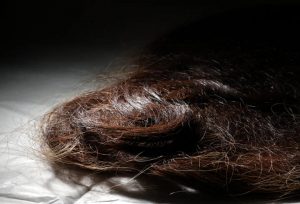Documenting Hiroshima of 1945: August 21, increased cases of blood disorders, hair loss
Aug. 21, 2024
by Kyosuke Mizukawa, Senior Staff Writer
On August 21, 1945, when hospital director Michihiko Hachiya, who died in 1980 at the age of 76, was making the rounds of patients at the Hiroshima Teishin Hospital (in the city’s present-day Naka Ward), he noticed signs that the number of people dying from the atomic bombing was continuing to increase. In his Hiroshima Diary, published in 1955, an account in which he recorded his activities and state of mind on a daily basis starting on August 6, Mr. Hachiya wrote that more patients had been exhibiting subcutaneous hemorrhagic spotting.
The hospital was located around 1.4 kilometers northeast of the hypocenter. Its windows had been blown out and most medical equipment was irreparably damaged, but the hospital still accommodated many A-bomb survivors.
The spotting was caused by a decrease in the number of blood platelets, which are essential in the blood-clotting process. In Hiroshima Diary, the entry dated August 19 indicates that more and more people were dying with mouth ulcers and subcutaneous bruising. The number of deaths peaked immediately after the bombing, but after a brief pause, deaths began to rise again. This situation differed from the one immediately after the bombing, which was marked by people dying from severe burns and injuries.
In addition, when Dr. Hachiya examined blood samples under a microscope that had arrived at the hospital on August 20, he found that the white blood cell counts in many of the patients were lower than normal. He became convinced (as indicated in the entry dated August 20) that the patients had developed blood diseases.
Starting around August 20, the third week after the atomic bombing, an increased frequency was observed of blood disorders, which developed when bone marrow stem cells involved in the production of blood cells were damaged by radiation. Mr. Hachiya had heard from military officials on August 12 that the weapon used on Hiroshima was an atomic bomb. The effects on human bodies, however, were still completely unknown at the time.
The Hiroshima Diary entry dated August 21 indicated that another new discovery was observed when one patient’s hair had fallen out in clumps. The hair loss was caused by radiation damage to hair root cells. The Hiroshima Peace Memorial Museum has on exhibit the hair of Hiroko Yamashita, who experienced the atomic bombing at her home around 800 meters from the hypocenter and died in 2014 at the age of 87. She lost her hair on August 21. Her younger brother Yusaku, six at the time, who also experienced the bombing at home and lost his hair on the same day, suffered bleeding from his nose and died on August 24.
(Originally published on August 21, 2024)
On August 21, 1945, when hospital director Michihiko Hachiya, who died in 1980 at the age of 76, was making the rounds of patients at the Hiroshima Teishin Hospital (in the city’s present-day Naka Ward), he noticed signs that the number of people dying from the atomic bombing was continuing to increase. In his Hiroshima Diary, published in 1955, an account in which he recorded his activities and state of mind on a daily basis starting on August 6, Mr. Hachiya wrote that more patients had been exhibiting subcutaneous hemorrhagic spotting.
The hospital was located around 1.4 kilometers northeast of the hypocenter. Its windows had been blown out and most medical equipment was irreparably damaged, but the hospital still accommodated many A-bomb survivors.
The spotting was caused by a decrease in the number of blood platelets, which are essential in the blood-clotting process. In Hiroshima Diary, the entry dated August 19 indicates that more and more people were dying with mouth ulcers and subcutaneous bruising. The number of deaths peaked immediately after the bombing, but after a brief pause, deaths began to rise again. This situation differed from the one immediately after the bombing, which was marked by people dying from severe burns and injuries.
In addition, when Dr. Hachiya examined blood samples under a microscope that had arrived at the hospital on August 20, he found that the white blood cell counts in many of the patients were lower than normal. He became convinced (as indicated in the entry dated August 20) that the patients had developed blood diseases.
Starting around August 20, the third week after the atomic bombing, an increased frequency was observed of blood disorders, which developed when bone marrow stem cells involved in the production of blood cells were damaged by radiation. Mr. Hachiya had heard from military officials on August 12 that the weapon used on Hiroshima was an atomic bomb. The effects on human bodies, however, were still completely unknown at the time.
The Hiroshima Diary entry dated August 21 indicated that another new discovery was observed when one patient’s hair had fallen out in clumps. The hair loss was caused by radiation damage to hair root cells. The Hiroshima Peace Memorial Museum has on exhibit the hair of Hiroko Yamashita, who experienced the atomic bombing at her home around 800 meters from the hypocenter and died in 2014 at the age of 87. She lost her hair on August 21. Her younger brother Yusaku, six at the time, who also experienced the bombing at home and lost his hair on the same day, suffered bleeding from his nose and died on August 24.
(Originally published on August 21, 2024)








